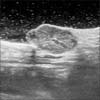Abstract
Nodular hidradenoma was diagnosed in a 29-month-old girl on her axilla. Hidradenoma, sometimes designated as acrospiroma, is a benign sweat gland neoplasm, which mostly occurs in adults. Very few cases of hidradenoma have been documented in children in their first decade of life. This case demonstrates that when a child develops a skin nodule, nodular hidradenoma can be a diagnostic option.
Nodular hidradenoma is a benign skin tumor with sweat gland origin. It mostly occurs in adults, but a few cases of nodular hidradenoma in children have been reported. It grows slowly, over a long period of time, and without symptoms [1]. At present, complete excision with tumor free margins is thought to be a standard treatment for hidradenoma, because malignant transformation may occur [2]. Herein, we present a case of nodular hidradenoma in a 29-month-old girl on her left axilla.
A 29-month-old girl was referred to our department with a one-year history of tender, asymptomatic, multiple verruciform nodule under the left axillary area (Fig. 1). Its initial size was about 0.5 cm in diameter, and has slowly grown over a year to 2 cm in diameter. Ultrasonography revealed a well-defined ovoid hypoechoic mass at the subcutaneous layer, with prominent internal vascularity, and several small internal cystic areas (Fig. 2). Excisional operation was done, and histopathologic examination showed a well-demarcated lobulated dermal nodule, with solid and cystic areas. The lesion was centrally located in the dermis, with no connection to the overlying epidermis. Both solid and cystic areas consisted of polygonal cells, with abundant eosinophilic to pale cytoplasm. Occasional ductal differentiation lined by cuboidal epithelium was observed. No nuclear atypia, necrosis or abnormal mitosis was found (Fig. 3). The histological findings were consistent with the diagnosis of nodular hidradenoma. During 3 years of the follow up period, the tumor didn't recur.
Nodular hidradenoma, which is an uncommon benign skin tumor of the sweat gland, has several designations, including eccrine acrospiroma, and clear cell hidradenoma. The age presentation varies, but mainly occurs in adults, with a peak incidence in the seventh decade [1]. Women are more affected than men, and head and upper extremities are more frequently involved than lower extremities [3]. Few cases of hidradenoma that occurred in children in their 1st decade have been reported [4]. It usually presents as a solitary, tender nodule or papule, with a size of 1 to 2 cm in diameter. It is usually asymptomatic, grows slowly over many years, and has a high locoregional reccurence rate [4].
Pathologically, hidradenomas are circumscribed, noncapsulated, multilobular masses that lie in the dermis, with no connection to the overlying epidermis [5]. They are mainly solid, but may show cystic areas containing mucinous material. Ductal differentiations are often present. They are composed of multiple lobulated masses of epithelial cells and tubular lumina of variable size and number [56]. Malignant transformations, known as hidranocarcinoma, are rare, and generally develops de novo but can evolve from a preexisting benign hidradenoma in extremely rare case [67]. After the malignant transformations, it shows slowly growing and no obvious changing for several years. Metastases may occur first in regional lymph nodes and the most common hematogenic metastases appear in lung. In widespread disease, chemotherapy and radiotherapy have proven ineffective [7]. The definitive treatments for both hidradenoma and hidradenocarcinoma is complete excision [567].
In summary, this case confirms that nodular hidradenoma can develop in a child as young as 29 months of age, which, to our knowledge, is the youngest yet to be reported. Once the diagnosis is established, long-term follow-up after complete excision is recommended, for the possibility of malignant transformation.
Figures and Tables
Fig. 1
Multiple exophytic and verruciform nodules of about 2 cm in diameter with well-vascularized surface located on the left axilla.

Fig. 2
Ultrasonographic finding reveals well-defined ovoid hypoechoic mass at the subcutaneous layer with several small internal cystic areas.

Fig. 3
(A) Microphotograph shows solid and partially cystic mass in dermis. No connection was found between the lesion and epidermis (H&E stain, ×100). (B, C) Microphotograph shows polygonal cells with eosinophilic to clear cytoplasm in both solid and cystic areas (H&E stain, ×200). (D) Microphotograph shows ductal differentiation. Hyalinization of fibrous stroma is identified (H&E stain, ×400).

References
1. Abenoza P, Ackerman AB. Neoplasms with eccrine differentiation: Ackerman's histologic diagnosis of neoplastic skin diseases: a method by pattern analysis. Philadelphia: Lea and Febiger;1990.
2. Yavel R, Hinshaw M, Rao V, Hartig GK, Harari PM, Stewart D, et al. Hidradenomas and a hidradenocarcinoma of the scalp managed using Mohs micrographic surgery and a multidisciplinary approach: case reports and review of the literature. Dermatol Surg. 2009; 35:273–281.
3. Hernández-Pérez E, Cestoni-Parducci R. Nodular hidradenoma and hidradenocarcinoma. A 10-year review. J Am Acad Dermatol. 1985; 12:15–20.
4. López V, Santonja N, Calduch-Rodríguez L, Jordá E. Poroid hidradenoma in a child: an unusual presentation. Pediatr Dermatol. 2011; 28:60–61.
5. Storm CA, Seykora JT. Cutaneous adnexal neoplasms. Am J Clin Pathol. 2002; 118:Suppl. S33–S49.
6. Stratigos AJ, Olbricht S, Kwan TH, Bowers KE. Nodular hidradenoma. A report of three cases and review of the literature. Dermatol Surg. 1998; 24:387–391.
7. Nazerali RS, Tan C, Fung MA, Chen SL, Wong MS. Hidradenocarcinoma of the finger. Ann Plast Surg. 2013; 70:423–426.




 PDF
PDF ePub
ePub Citation
Citation Print
Print


 XML Download
XML Download